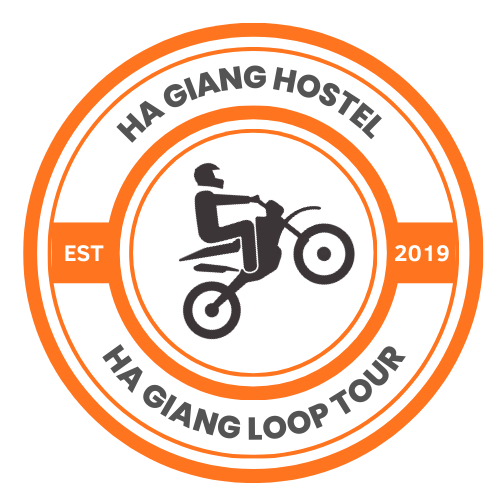Planning the Ha Giang Loop and wondering whether Lung Cu Flag Tower deserves a spot on your route? The short answer: absolutely. Perched above dramatic limestone ridges in Dong Van District, Lung Cu Flag Tower (Cột cờ Lũng Cú) stands as a symbolic northern landmark offering sweeping views over terraced valleys and the Vietnamese–Chinese borderlands. Whether you’re mapping a 2D1N, 3D2N, or 4D3N itinerary, this stop adds cultural depth, breathtaking viewpoints, and a rewarding climb without throwing off your travel schedule.
This guide covers everything you need: what to expect on arrival, the best time to visit, how to include the tower in different trip lengths, and transport options whether you’re riding solo, joining an easy-rider tour, or taking a Jeep or private car. Starting from a rider-friendly base like Ha Giang Hostel makes logistics easier, so you can focus on enjoying the mountains rather than worrying about tickets, timing, or parking.
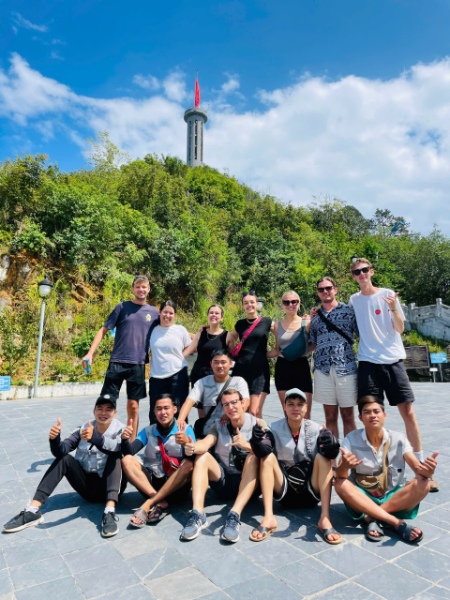
What & Where Is Lung Cu Flag Tower?
Lung Cu Flag Tower stands in Lung Cu Commune, Dong Van District, Ha Giang Province close to the symbolic northern tip of Vietnam. The octagonal tower crowns a hilltop with a spacious viewing deck. On clear days, you can see layers of limestone karsts, narrow valleys dotted with H’Mong hamlets, and winding mountain roads stretching toward the horizon.
Most Ha Giang Loop riders base themselves in Dong Van or Meo Vac for this leg of the journey. From Dong Van town, the ride to the tower usually takes less than an hour, with plenty of scenic stops along the way. Road conditions vary depending on weather and maintenance, so keep a moderate pace and plan to arrive before sunset for the best experience.
A Short History & Symbolism
While Lung Cu is often introduced as Vietnam’s “northernmost point,” the true extreme lies a short distance farther, marked by border posts in the surrounding highlands. The tower itself has evolved from a modest flagpole into a reinforced monument, reflecting a broader story of national identity and presence in these mountainous frontier regions.
Design elements such as the octagonal base and drum-inspired motifs pay tribute to Vietnam’s long history, while the immense flag above the platform serves as a reminder that this geography is not just symbolic it is living, cultivated land. Here, communities continue to shape the slopes with terraced fields, seasonal harvests, and market rhythms as vivid and enduring as the cliffs that frame them.
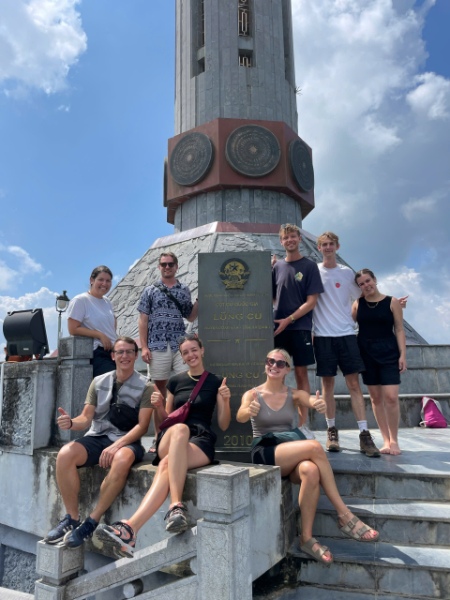
Essential Visitor Facts
Altitude & Views: Expect sweeping panoramas from both the top platform and inside the tower’s upper staircase. Visibility is best on clear mornings, especially after rainfall when the air is crisp and the mountains appear sharper.
Steps & Access: You’ll ascend a series of stone steps to the base, then climb a final spiral staircase inside the tower. Take short breathers along the way and bring water, particularly during warmer months.
Tickets & Opening Hours: A small entry fee applies, and operating hours can vary by season or public holidays. Bring small cash for tickets, buggy or parking services (if available), and refreshments at the base.
Facilities: Simple kiosks and cafés near the parking area operate on most days. Restrooms are basic—plan your restroom stops before or after the visit if possible.
Etiquette: Maintain drone distance from people and livestock, and always ask permission before photographing portraits in nearby villages.
Best Time to Visit Lung Cu
The Ha Giang Loop is rideable year-round, but the best periods to visit Lung Cu are typically from September to November and March to May. During these months, the skies are clearer, temperatures are mild, and the limestone karsts stand out beautifully on camera.
Summer brings a vibrant green landscape but also sudden tropical showers, which can make roads slick. In contrast, winter at altitude feels colder than expected, with fog that can roll in quickly and obscure the views. If visibility drops, it’s best to wait for a clear window rather than tackling exposed ridges in misty conditions.
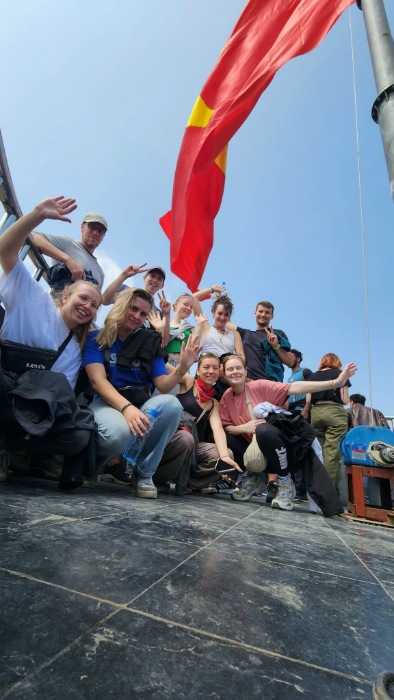
Getting There on the Ha Giang Loop
From Ha Giang City, most riders follow a scenic multi-stage route north through Quan Ba and Yen Minh before reaching Dong Van. If you’re based in Dong Van, Lung Cu makes an ideal half-day excursion: set off after breakfast, climb the tower, linger for photos, and return to town for lunch before continuing toward Ma Pi Leng Pass.
Avoid riding after dark, as mountain visibility drops quickly. The roads are paved but winding, with blind corners, livestock crossings, and occasional gravel—especially after rain. Keep speeds conservative, and pull over often to enjoy the views safely.
How to Fit Lung Cu into Your Ha Giang Loop Route (2D1N / 3D2N / 4D3N)
Ha Giang Loop 2D1N (Express):
This is a fast-paced route best suited to confident riders or travelers riding pillion with an easy-rider. You can fit Lung Cu into the schedule if you overnight in Dong Van, start early, and keep your stops focused. Climb the tower in the morning for cooler air and softer light, then continue directly toward Ma Pi Leng Pass and Meo Vac.
Ha Giang Loop 3D2N (Classic):
Day 2 is your Lung Cu day: ride Dong Van → Lung Cu → back to Dong Van for lunch → Ma Pi Leng scenic section → overnight near Meo Vac or Du Gia (depending on season and road conditions). You’ll have enough time for the full stair climb, panoramic photos from the viewpoint, and a relaxed coffee stop in a nearby village before descending toward Ma Pi Leng.
Ha Giang Loop 4D3N (Scenic & Relaxed):
Perfect for photographers and first-time riders who prefer shorter daily distances. Enjoy a slow morning at the tower, explore quieter backroads and golden-hour viewpoints, and, in the right season, add a stop at a local waterfall. This version trades miles for meaningful moments and your photos will show it.
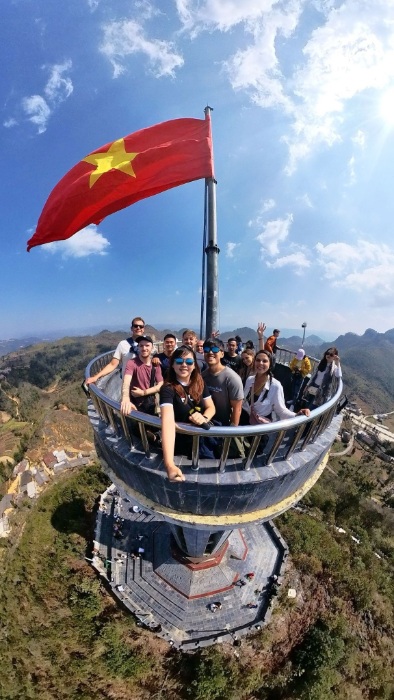
Culture Stops Near the Tower
Lo Lo Chai Village: A small settlement of traditional earthen houses, known for its handwoven textiles and photogenic stone lanes. Please be respectful—ask before taking portraits, and consider supporting local craft stalls.
Dong Van Old Quarter: A charming pocket of stone houses with a relaxed market-town feel, especially lively on weekends when vendors gather from nearby hamlets.
Vuong Palace (H’Mong King’s Palace): Timbered courtyards, carved stone architecture, and a sense of history that pairs perfectly with a visit to Dong Van on the same day.
Ma Pi Leng Pass & Nho Que River: The Loop’s most dramatic cliffs and river views—plan to ride this section in daylight for both safety and scenery.
Safety, Etiquette & Practical Tips
Licensing & Insurance: If you’re self-riding, carry both your home-country driver’s license and an International Driving Permit (IDP) that explicitly covers motorbikes. Confirm that your travel insurance includes motorbike coverage in Vietnam.
- Pace Yourself: Mountain weather can change quickly. If fog or rain rolls in, pull over and wait it out before crossing exposed ridges—visibility and traction can drop in minutes.
- Gear & Checks: Before leaving town, always check your brakes, lights, horn, and tire pressure. Wear gloves and a quality helmet with a clear visor—visibility is just as important as protection.
- Cash & Connectivity: Bring small denominations for entry tickets, drinks, and parking. Mobile data is spotty in some valleys, so download offline maps or GPS routes before setting out.
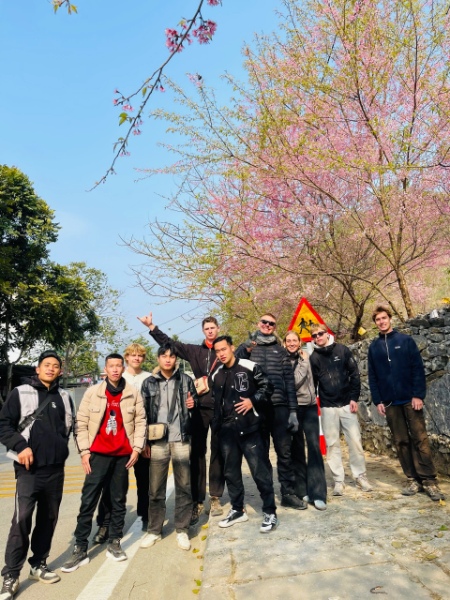
No License? Short on Time? You Still Have Options
You don’t need to self-ride to experience Lung Cu. Many travelers opt for an easy-rider, a private car tour, or a Jeep experience for an open-air, photo-friendly day. These options are perfect during rainy or cold months, or when you’d rather focus on the scenery than the switchbacks.
Architecture & Details to Notice
Take a moment to look closely at the tower’s base and reliefs. The octagonal foundation and drum-inspired motifs reflect elements of traditional Vietnamese design. Climbing the final staircase inside the tower adds both symbolism and perspective—step out onto the viewing deck and watch as the limestone ridgelines unfold in soft, layered horizons.
Sample Half-Day Plan from Dong Van
07:30 – Depart Dong Van after a light breakfast.
08:30 – Park at the Lung Cu base and begin the ascent (or take the on-site buggy if available).
09:00–10:00 – Climb the tower, explore viewpoints, and capture photos.
10:15 – Enjoy a coffee stop in a nearby village such as Lo Lo Chai.
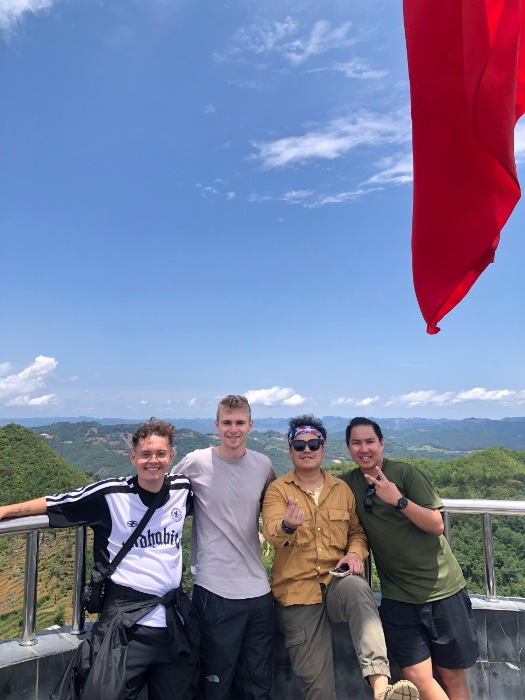
Tour Options with Ha Giang Hostel (Daily 8:30 AM)
Ha Giang Hostel offers daily small-group departures at 8:30 AM, typically with 6–8 guests per group—a friendly, safe pace ideal for meeting fellow riders and enjoying guided support on the road.
For those seeking a more personal experience or specific photo opportunities, private motorbike tours can be arranged. Non-riders can choose between a private car (sedan or SUV) or an iconic Jeep experience for open-air comfort and easy photography access.
All formats are available as Ha Giang Loop 2D1N, 3D2N, or 4D3N itineraries, and can be tailored to your preferred route and the season’s best viewpoints. After the ride, relax back at the hostel with hot showers, fresh towels, and a pool dip, while laundry and luggage storage services keep the rest of your Loop light and easy.
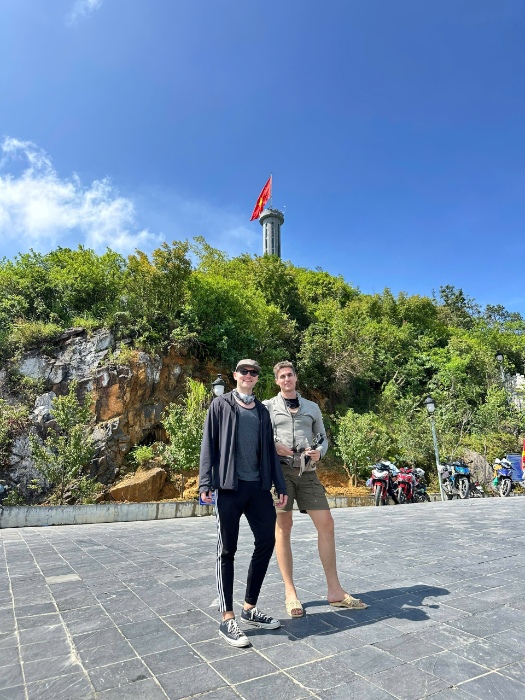
Frequently Asked Questions – FAQ
Is Lung Cu suitable for first-time riders?
Yes—if you manage time and daylight. Roads are paved but winding. Start early, take it slow on blind corners, and avoid riding back in the dark.
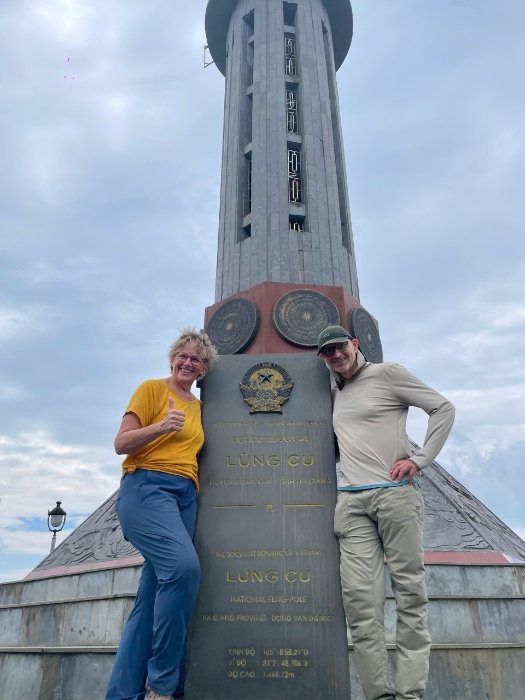
How long should I budget for the stop?
Plan about 90–120 minutes to park, climb, enjoy the viewpoints, and take photos. Add buffer for coffee or village stops.
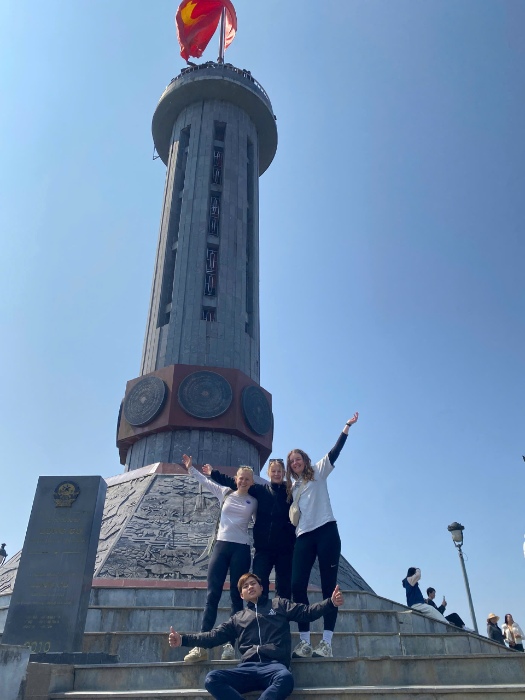
What should I bring?
Water, sunscreen, a light rain layer (even on clear mornings), and sturdy footwear for the steps. A power bank helps, as signal can be patchy.
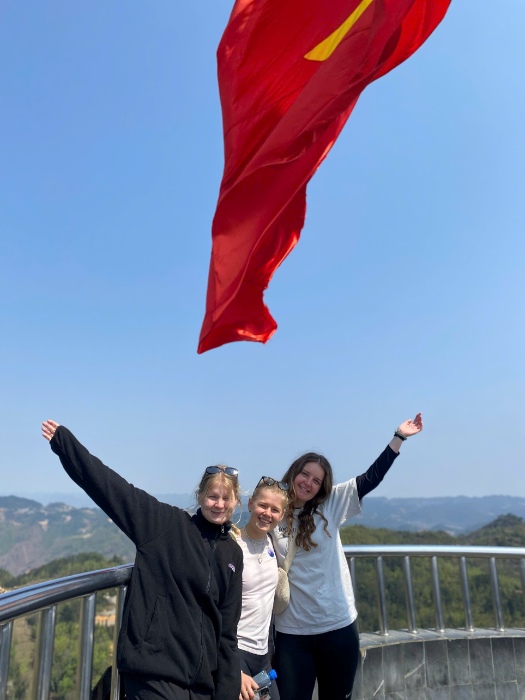
Can I visit Lung Cu on a Ha Giang loop tour without riding?
Absolutely. Choose an easy-rider, private car, or Jeep tour. You’ll see the same highlights without managing the bike yourself.
When is the best time for photos?
Clear mornings are ideal for long views. Late afternoons can deliver warm light, but plan descent with plenty of daylight remaining.
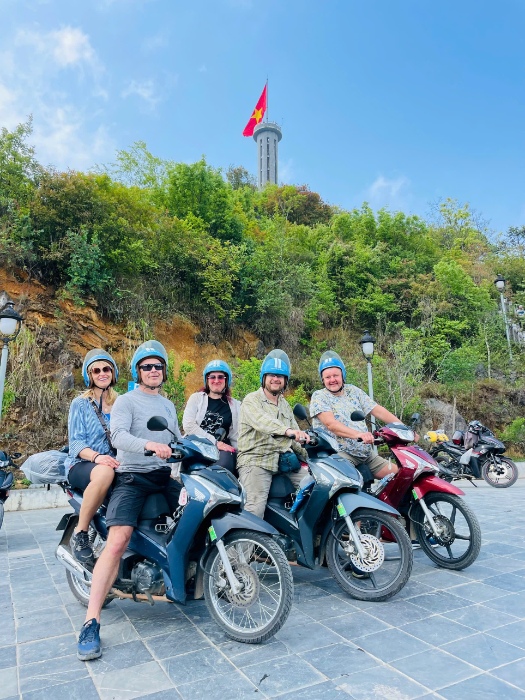
Final Word
Lung Cu Flag Tower is more than just a pin on the map it’s a high point, both literally and figuratively, of the Ha Giang Loop. Time your visit for the best light, climb at a relaxed pace, and let the landscape tell its story. Whether you’re self-riding or joining an easy-rider, car, or Jeep tour, weave Lung Cu into a route that suits your pace and the season’s rhythm. Start from a smart base, plan your fuel and food stops, and you’ll remember this climb long after your engine cools and the mountains fade in the rearview mirror.
Contact & Booking (Ha Giang Hostel #1 for the Ha Giang Loop)
- WhatsApp: +84 982 818 385
- Gmail: Hagianghostels@gmail.com
- Website: https://hagianghostel.com
- Same‑day bikes, daily 8:30 AM small‑group departures (6–8 guests), private motorbike/car/Jeep tours, and bus transfers from Hanoi, Sapa, Ha Long, Cat Ba, and Ninh Binh.
